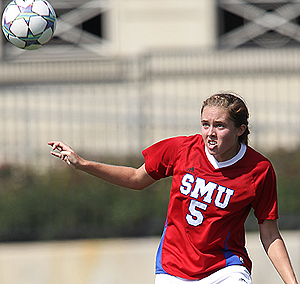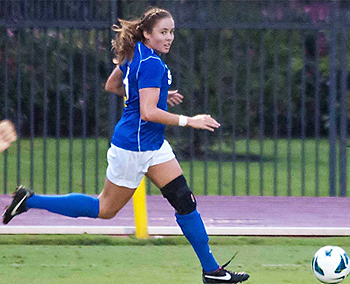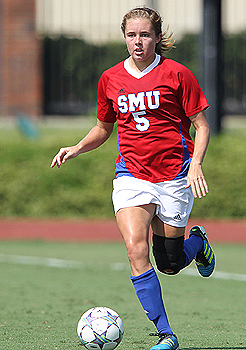 |
| Defender Courtney Smith said she is looking forward to receiving medical clearance in time to play in SMU spring games (photo by SMU athletics). |
|
Playing through pain is one of the basic rules of virtually every athleteΓÇÖs life. The same competitive nature that allows athletes to excel at the highest levels also allows them to perform despite sometimes-debilitating pain. From mild sprains and strains to season-ending torn ligaments, injuries are a way of life in sports. Most athletes, at some point, have played through a sprained ankle or twisted knee, gritting their teeth to perform and help their team until the pain becomes unbearable or there is a risk of further injury.
With that as a backdrop, consider the case of Courtney Smith, a defender on the SMU women’s soccer team, who played her entire junior season in 2012 with a broken bone … in her foot.
Most soccer players run an estimated six to eight miles in each game, sprinting, stopping and changing direction constantly, and of course, players use both feet to strike the ball.
The left-footed Smith broke the fifth metatarsal bone in her right foot sometime before the 2012 season, and while it is not her primary kicking foot, she (like all players) does kick with both, and as the MustangsΓÇÖ first option on all corner kicks and long free kicks, she puts a lot of pressure on her (right) plant foot.
ΓÇ£IΓÇÖm not exactly sure when I did it,ΓÇ¥ Smith said. ΓÇ£They (doctors) said it was (last) spring. They thought I had rolled my ankle, and I went all summer and preseason before it really bothered me. I just thought it was a normal ankle sprain. Then, in the beginning of the week of our pre-conference game against Baylor, it really started to bother me, so I got X-rays. They saw the fracture, and a foot specialist said it was about six months old. ItΓÇÖs one of those things thatΓÇÖs supposed to heal on its own, but I guess it didnΓÇÖt.ΓÇ¥
As if that weren’t enough, Smith’s shoulder popped out during SMU’s tie with Colorado College, an injury that SMU women’s soccer head coach Chris Petrucelli said he feared might shelve his all-conference defender for “a couple of weeks.” Smith missed the rest of that game … and started the next game.
SmithΓÇÖs shoulder injury was one thing, but once it was popped back in to place, her return to the field was a matter of how much pain she could endure. The beating a soccer playerΓÇÖs feet takes in every game ΓÇö and practice ΓÇö makes SmithΓÇÖs performance in 2012 even more remarkable. Teammate Shelby Redman equated the idea of playing soccer with a broken foot to pitching a full season of baseball with a broken bone in a pitcherΓÇÖs throwing hand.
ΓÇ£It was extremely impressive, playing through an injury like that,ΓÇ¥ Petrucelli said. ΓÇ£I think most players would have been done for the season. She was playing on one leg, with one arm, and she didnΓÇÖt miss a game.
ΓÇ£She is certainly in the group of the toughest players IΓÇÖve had. SheΓÇÖs in a group of a couple of having extremely high pain tolerance. She can handle just about anything.ΓÇ¥
Smith dismisses the idea that her tolerance of pain is somehow significantly higher than anyone elseΓÇÖs. Instead, she said that once she learned that her foot was broken, but that playing would not risk further injury, Smith said she did not consider shutting it down for surgery.
“I know it sounds cliché,” she said, “but I just love the game so much that I take every game as a gift. I don’t want to miss out.”
Once she ruled out surgery, Smith and the SMU training staff coordinated a plan to ease her discomfort as much as possible.
“They were great,” Smith said of the athletic trainers. “They did everything you can imagine — they used laser treatment, a bone stimulator … they even put a steel insert in my shoe to decrease movement, or flexion, in the shoe.”
What appears to be beyond debate is that SmithΓÇÖs love of soccer is matched perhaps only by her tolerance for pain.
ΓÇ£Coaches will ask, ΓÇÿare you in pain, or are you injured?ΓÇÖΓÇ¥ Smith said. ΓÇ£I just thought I was in pain, and if that was the case, thereΓÇÖs no way I wasnΓÇÖt playing.ΓÇ¥
ΓÇ£ItΓÇÖs an interesting thing. ItΓÇÖs one of these things a lot of high-level athletes go through,ΓÇ¥ Petrucelli said. ΓÇ£Coaches have to make decisions because youΓÇÖll never know how hurt she is, and sheΓÇÖll always tell you sheΓÇÖs fine. You always have to judge her effectiveness, knowing that sheΓÇÖll play through anything.ΓÇ¥
 |
| SMU head coach Chris Petrucelli said Courtney Smith already is good enough to play right now for any team in the new NWSL. (photo by SMU athletics). |
|
ΓÇ£(Petrucelli) was very careful with my foot,ΓÇ¥ Smith said. ΓÇ£He controlled the amount of time that I practiced. Our coaches are really smart about recovery time, from injuries or after tough games, and are very aware of what each player needs.ΓÇ¥
Smith acknowledged that while she was able to grit through the pain, it did, at times, affect her performance.
ΓÇ£The pain definitely affected my play,ΓÇ¥ Smith said. ΓÇ£A lot of it was the long, overlapping runs and keeping up with speedy players. I also struggled when IΓÇÖd make a hard run forward ΓÇö it wouldnΓÇÖt be the run, so much, but the run back afterward. Once the steel insert got put in, it made it a little easier.ΓÇ¥
ΓÇ£When they said that it was fractured, they said it had been six months. I went through all of spring, I played with the FC Dallas semi-pro team, I lifted weights with (SMU strength and conditioning coordinator) Mel (de Laura) and I didnΓÇÖt feel anything. It was bizarre that it had been six months and I hadnΓÇÖt felt a thing. That kind of blew my mind.
ΓÇ£After I told (Petrucelli) about the fracture, he came up with a plan to decrease my practice time. He said if it felt uncomfortable, heΓÇÖd take me out, which I hated hearing.ΓÇ¥
Smith dismisses the idea that her tolerance of pain is higher than anyone elseΓÇÖs, citing instead her obsession with her sport as the driving force behind her unending effort to get on the field.
“I wouldn’t say it’s toughness,” she said. “I’m just super-passionate for the game. Any time losing minutes, having to sit out … that’s time not being able to do what you want to do. It’s tough.”
SmithΓÇÖs modesty, however, might be just that: modesty. Redman, who has played with Smith since the sixth grade, said SmithΓÇÖs toughness is no mirage.
ΓÇ£Courtney has a great attitude. She always has,ΓÇ¥ Redman said. ΓÇ£SheΓÇÖs not one to say sheΓÇÖs injured ΓÇö ever. SheΓÇÖs not someone who thinks not playing is an option. If she can walk, sheΓÇÖll play, and we all know it.ΓÇ¥
Part of SmithΓÇÖs drive stems from the fact that professional opportunities for women are limited. While Petrucelli says she could make any team in the new National WomenΓÇÖs Soccer League right now (ΓÇ£left-sided players are hard to find, and sheΓÇÖs an excellent left-sided player who can play in the back or in the midfield ΓÇö she could make any team in the league today,ΓÇ¥ he said), Smith said she lobbied to continue playing in part because she was growing more aware of the fact that the end of her college career was getting closer.
ΓÇ£You start to count. You know you only have so many games left,ΓÇ¥ she said. ΓÇ£Where I am now, I could count how many games I have left. I want to keep playing as long as I can. I have talked about it with Chris and (SMU assistant coach) Nicole (Nelson) ΓÇö If I canΓÇÖt play (in the United States), IΓÇÖd like to play overseas. I love traveling, and I obviously love soccer.
“When I was with the ODP (Olympic Developmental Pool) for the Regional Team, I had the opportunity to go to Costa Rica, Italy, Portugal and Spain (between 10th and 11th grade). When I was in Europe, we got to play against professional soccer teams over there. My dream would be to go over to Germany and play in the professional league there. They have a really good professional club system there … and while I was in my cast, I bought the Rosetta Stone software. Now I’m learning German.”
 |
| Smith takes most free kicks for the Mustangs and led her team with 10 assists in 2012 (photo by SMU athletics). |
|
Smith said she is hoping to play in the MustangsΓÇÖ spring games ΓÇö games which Petrucelli rescheduled until after spring break so Smith could play.
ΓÇ£I talked about sitting out spring with my family, but I didnΓÇÖt want to,ΓÇ¥ Smith said. ΓÇ£I made a commitment to SMU, to the coaching staff and my teammates to play to the best of my ability. With the athletic trainers we have and the medical staff we have here, I feel confident theyΓÇÖll be able to get me out there.
ΓÇ£I tried not to change how I played. Chris still expected me to make long runs, as the outside back. Obviously I had to do those to be able to play.ΓÇ¥
SmithΓÇÖs fanaticism for soccer is not lost on her coach or her teammates.
ΓÇ£CourtneyΓÇÖs a great player,ΓÇ¥ Redman said. ΓÇ£Her exceptional qualities are expectations to her, but even with her limitations last year, sheΓÇÖs still a great player. Most people, if they hadnΓÇÖt known she was injured, wouldnΓÇÖt have been able to tell just by watching her.
ΓÇ£Her toughness is contagious. I think a lot of us looked at her and thought, ΓÇÿif she can play with a broken foot, this bruise isnΓÇÖt that bad, or this sprained ankle isnΓÇÖt that bad.ΓÇÖ Her toughness made all of us tougher.ΓÇ¥
Smith had her foot surgically repaired after the season, and has been working diligently on her rehabilitation ever since. She was cleared earlier this week to work ΓÇ£toward jumping and lateral movementsΓÇ¥ and has done limited cutting and jumping rope, with the hope of being fully cleared after spring break so she can play in the MustangsΓÇÖ spring games.
ΓÇ£IΓÇÖm itching to get back on the pitch,ΓÇ¥ she said. ΓÇ£ItΓÇÖs killing me to just watch spring practice.ΓÇ¥









